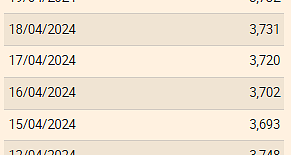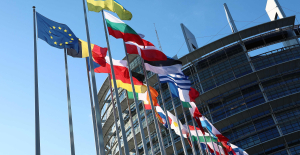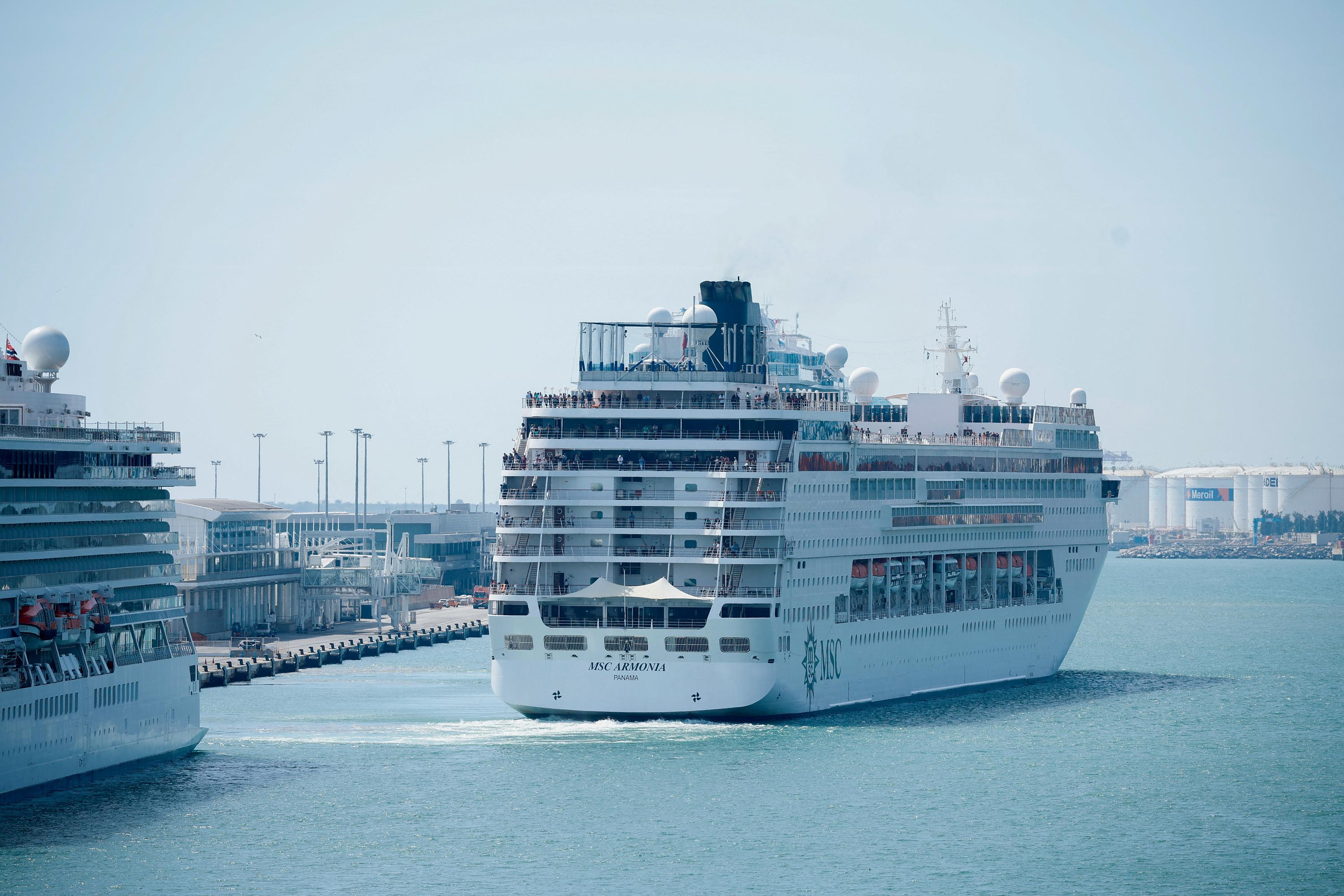Hamburg's port is to be climate-neutral by 2040, handle a little more than a third of today's volume and act as a digital, highly innovative center of the European maritime economy. These are some of the core statements from the confidential draft of the "Port Development Plan 2040", which has been awaited for months and which is available to WELT.
On Thursday, the Hamburg Economic Authority and the Hamburg Port Authority (HPA) submitted the draft to the associations involved in developing the port strategy, such as the environmental associations or the UVHH business association. The Senate intends to adopt the new port development plan by the end of the year and introduce it to the parliament.
The document contains a first part of 41 pages, in which the situation of the port and its development prospects for the coming decades are outlined. The second, 46-page part describes the desired implementation of the measures, for example in digitization, infrastructure or climate protection, but also in the interaction of port and urban development.
The port development plan stands in sharp contrast to a thesis paper from the "Hamburg Convention" from a few days ago, which suggests greater use of port areas for scientific purposes and considers stagnation in the port's handling volumes to be acceptable.
The port strategy of the red-green Senate, on the other hand, aims to make the port not only an innovation engine for itself, but for the entire metropolitan region. “The Port of Hamburg is also positioning itself in 2040 as one of the leading logistics hubs in Europe. It is characterized by goods handling, cruise shipping, a diverse corporate landscape of traditional and new port companies and a broad, climate-neutral industrial base," says the introductory passage. "With their sustainable added value, the companies in the port are the economic engine of the entire region."
The new port development plan replaces the last such paper from 2012. The public debate about the new plan will begin at an extremely difficult time for the port: the federal government cannot maintain the drafts hoped for from the ninth Elbe deepening for the largest seagoing vessels , calling at Hamburg. There is no long-term concept for dealing with the increasing amounts of sediment in the Lower Elbe, which Hamburg must develop together with the federal government and neighboring states in order to keep Germany's largest seaport competitive.
The dispute over Cosco's planned participation in HHLA's Tollerort terminal has shown that the Port of Hamburg must reconsider and possibly correct its high dependence on trade with China, which accounts for 30 percent of container throughput. The failed attempt this summer to bring a floating import terminal for deep-frozen, liquefied natural gas (LNG) to the Port of Hamburg in 2023 could result in Hamburg being much more closely knit than it has been with the ports of Stade and Stade in the forthcoming transformation of the energy industry Brunsbüttel cooperates - not only with LNG, but also in a future hydrogen economy.
In terms of volume development, the draft of the 2040 port development plan is significantly more defensive than the 2012 plan. At the time, Hamburg still had an annual handling potential of up to 25 million container units (TEU). Since then, however, Hamburg's container handling has stagnated at around nine million TEU a year. Container traffic in Hamburg has never exceeded the ten million TEU mark.
Last year, Hamburg handled a total of 129 million tons of goods. “Prospectively, a moderate increase in turnover can be assumed. A handling forecast commissioned by the HPA predicts a market potential of 176.7 million tons for all goods handling and 13.1 million TEU for container handling by the year 2035 in the basic scenario. "That corresponds to an increase of about 37 percent in terms of tonnage."
From the point of view of the Senate and the port administration, the risks for port operations include the growing power of the shipping companies with fewer and larger players who are striving for more and more shares in port terminals and influence on the transport chain. The development of new flows of goods cannot be foreseen in an increasingly volatile world situation. Above all, the ship sizes that may continue to grow could have a negative effect for Hamburg.
The Port of Hamburg can handle container ships with today’s largest capacities of up to 24,000 TEU, some of which come fully loaded to the Hanseatic city – after considerable investments in quay facilities and container gantries in recent years, and at the price of a decades-long dispute over the deepening of the Elbe.
The shipping companies, on the other hand, have long been exploring whether much larger ships would be profitable. “Ships with slot capacities of more than 28,000 TEU are considered conceivable by experts. In the past, this development triggered adjustment processes in the ports. Hamburg therefore supports possible European initiatives to limit the growth in ship size,” says the draft port development plan.
One of the key points of the new port strategy is climate-neutral port operations by 2040. "The Port of Hamburg is significantly reducing greenhouse gas and pollutant emissions in handling and transport in order to make operations carbon-neutral from 2040 onwards," it says. "This is done with a technology-open approach that relies on the innovative potential on site."

 The Euribor today remains at 3.734%
The Euribor today remains at 3.734% Germany: the trial of an AfD leader, accused of chanting a Nazi slogan, resumes this Tuesday
Germany: the trial of an AfD leader, accused of chanting a Nazi slogan, resumes this Tuesday New York: at Columbia University, the anti-Semitic drift of pro-Palestinian demonstrations
New York: at Columbia University, the anti-Semitic drift of pro-Palestinian demonstrations What is Akila, the mission in which the Charles de Gaulle is participating under NATO command?
What is Akila, the mission in which the Charles de Gaulle is participating under NATO command? What High Blood Pressure Does to Your Body (And Why It Should Be Treated)
What High Blood Pressure Does to Your Body (And Why It Should Be Treated) Vaccination in France has progressed in 2023, rejoices Public Health France
Vaccination in France has progressed in 2023, rejoices Public Health France Food additives suspected of promoting cardiovascular diseases
Food additives suspected of promoting cardiovascular diseases “Even morphine doesn’t work”: Léane, 17, victim of the adverse effects of an antibiotic
“Even morphine doesn’t work”: Léane, 17, victim of the adverse effects of an antibiotic MEPs validate reform of EU budgetary rules
MEPs validate reform of EU budgetary rules “Public Transport Paris 2024”, the application for Olympic Games spectators, is available
“Public Transport Paris 2024”, the application for Olympic Games spectators, is available Spotify goes green in the first quarter and sees its number of paying subscribers increase
Spotify goes green in the first quarter and sees its number of paying subscribers increase Xavier Niel finalizes the sale of his shares in the Le Monde group to an independent fund
Xavier Niel finalizes the sale of his shares in the Le Monde group to an independent fund Owner of Blondie and Shakira catalogs in favor of $1.5 billion offer
Owner of Blondie and Shakira catalogs in favor of $1.5 billion offer Cher et Ozzy Osbourne rejoignent le Rock and Roll Hall of Fame
Cher et Ozzy Osbourne rejoignent le Rock and Roll Hall of Fame Three months before the Olympic Games, festivals and concert halls fear paying the price
Three months before the Olympic Games, festivals and concert halls fear paying the price With Brigitte Macron, Aya Nakamura sows new clues about her participation in the Olympics
With Brigitte Macron, Aya Nakamura sows new clues about her participation in the Olympics Skoda Kodiaq 2024: a 'beast' plug-in hybrid SUV
Skoda Kodiaq 2024: a 'beast' plug-in hybrid SUV Tesla launches a new Model Y with 600 km of autonomy at a "more accessible price"
Tesla launches a new Model Y with 600 km of autonomy at a "more accessible price" The 10 best-selling cars in March 2024 in Spain: sales fall due to Easter
The 10 best-selling cars in March 2024 in Spain: sales fall due to Easter A private jet company buys more than 100 flying cars
A private jet company buys more than 100 flying cars This is how housing prices have changed in Spain in the last decade
This is how housing prices have changed in Spain in the last decade The home mortgage firm drops 10% in January and interest soars to 3.46%
The home mortgage firm drops 10% in January and interest soars to 3.46% The jewel of the Rocío de Nagüeles urbanization: a dream villa in Marbella
The jewel of the Rocío de Nagüeles urbanization: a dream villa in Marbella Rental prices grow by 7.3% in February: where does it go up and where does it go down?
Rental prices grow by 7.3% in February: where does it go up and where does it go down? Europeans: “All those who claim that we don’t need Europe are liars”, criticizes Bayrou
Europeans: “All those who claim that we don’t need Europe are liars”, criticizes Bayrou With the promise of a “real burst of authority”, Gabriel Attal provokes the ire of the opposition
With the promise of a “real burst of authority”, Gabriel Attal provokes the ire of the opposition Europeans: the schedule of debates to follow between now and June 9
Europeans: the schedule of debates to follow between now and June 9 Europeans: “In France, there is a left and there is a right,” assures Bellamy
Europeans: “In France, there is a left and there is a right,” assures Bellamy These French cities that will boycott the World Cup in Qatar
These French cities that will boycott the World Cup in Qatar Serie A: Bologna surprises AS Rome in the race for the C1
Serie A: Bologna surprises AS Rome in the race for the C1 Serie A: Marcus Thuram king of Italy, end of the debate for the position of number 9 with the Blues?
Serie A: Marcus Thuram king of Italy, end of the debate for the position of number 9 with the Blues? Milan AC-Inter Milan: Thuram and Pavard impeccable, Hernandez helpless… The tops and flops of the derby
Milan AC-Inter Milan: Thuram and Pavard impeccable, Hernandez helpless… The tops and flops of the derby Ligue 2: Auxerre leader, Bordeaux in crisis, play-offs... 5 questions about an exciting end of the season
Ligue 2: Auxerre leader, Bordeaux in crisis, play-offs... 5 questions about an exciting end of the season


















